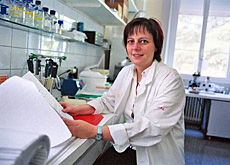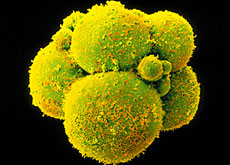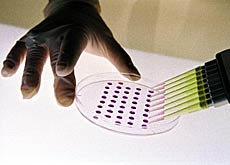Geneva joins race for stem cell breakthrough

Scientists in Geneva are aiming to produce the world's first "clean" line of stem cells for use in the treatment of degenerative diseases such as Parkinson's .
Based at a laboratory at the city’s University Hospital, the team face fierce competition from rivals in Europe and the United States.
The laboratory, which officially opened on Wednesday, will be run by researchers Anis Feki and Marisa Jaconi, the first person in Switzerland to carry out research with human embryonic stem cells.
“The aim is to isolate embryonic stem cells using a new procedure that avoids exposure of the cells to animal components, which carry the risk of infections. Most of the lines that are presently available in the world have been derived using bovine serum, for example, and are not suitable for clinical applications,” Jaconi told swissinfo.
“To be able to apply cells for regenerative medicine, we need clinical grade cells that are clean in the sense that they are not derived from anything to do with animals.”
The scientists have received a SFr770,000 ($620,000) three-year funding package from the Swiss National Science Foundation for their research.
Swiss in-vitro fertilisation centres have provided 100 surplus embryos donated by couples and dating from pre-2001, which had been earmarked for destruction.
A new law allowing stem cell research on surplus human embryos, which was backed by two-thirds of voters, came into force in Switzerland in March last year.
Clinical use
Jaconi, who has been working on imported human stem cells since 2002, says the Swiss research project is one of a number around the world striving to produce “clean” stem cell lines for clinical use.
According to the biologist, Geron, a California-based biopharmaceutical firm, is due to begin next year the first trials with human embryonic stem cells to try to repair spinal cord injuries.
She said scientists in Sweden and Finland had also informed her that they were ready to begin similar research as soon as they get clinical grade cells.
“There is a race in a sort of sense between Europe and the US as to who is going to be able to start the first tests on humans.”
First trials
Jaconi said the first tests would be done on seriously ill patients “who have no other hope than to try these kind of interventions”.
Embryonic stem cells can be transformed into almost any other cell in the body. Experts believe that they may eventually lead to treatments for a range of serious illnesses including Alzheimer’s, Parkinson’s, cardiovascular diseases and diabetes.
Cell replacement therapy and tissue engineering are two key areas of application.
The Geneva team have already defrosted 12 embryos, but four of them were unusable. They hope to be able to extract five stem cell lines from the 100 they have been given.
swissinfo, Adam Beaumont in Geneva
In November 2004 Swiss voters approved by a two-thirds majority a new law allowing research on stem cells from surplus human embryos.
The production of stem cells was limited to embryos no older than seven days. Therapeutic cloning and the trade in embryos remain outlawed, as does research on the embryos themselves.
Surplus embryos that were stored before the reproductive medicine law was amended in 2001 have to be destroyed by the end of 2005. If donated for research they can be kept until 2008.
For research to go ahead permission has to be granted by the Federal Office for Health and the ethics commission.
Stem cells are unspecialised cells, which can develop into any part of the human body. Because of this potential, researchers believe it will be possible one day to use them to fight degenerative diseases, such as Parkinson’s, spinal cord injury or myocardial infarction.
Stem cells are present mainly in the early stages of life, when the cells of a fertilised egg begin to multiply before developing into a human baby.
Stem cells are also found in the umbilical cord and in adults, but their potential is more limited than that of embryonic stem cells.

In compliance with the JTI standards
More: SWI swissinfo.ch certified by the Journalism Trust Initiative


You can find an overview of ongoing debates with our journalists here. Please join us!
If you want to start a conversation about a topic raised in this article or want to report factual errors, email us at english@swissinfo.ch.